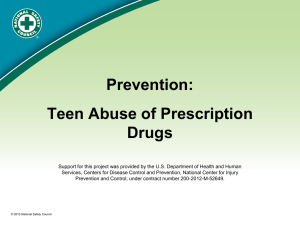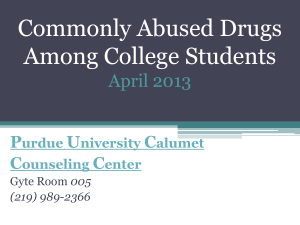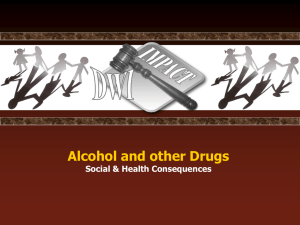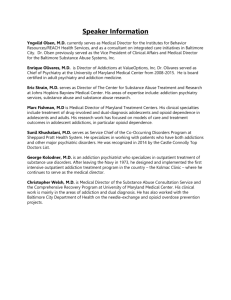APPALACHIAN ADDICTION & PRESCRIPTION DRUG ABUSE
advertisement
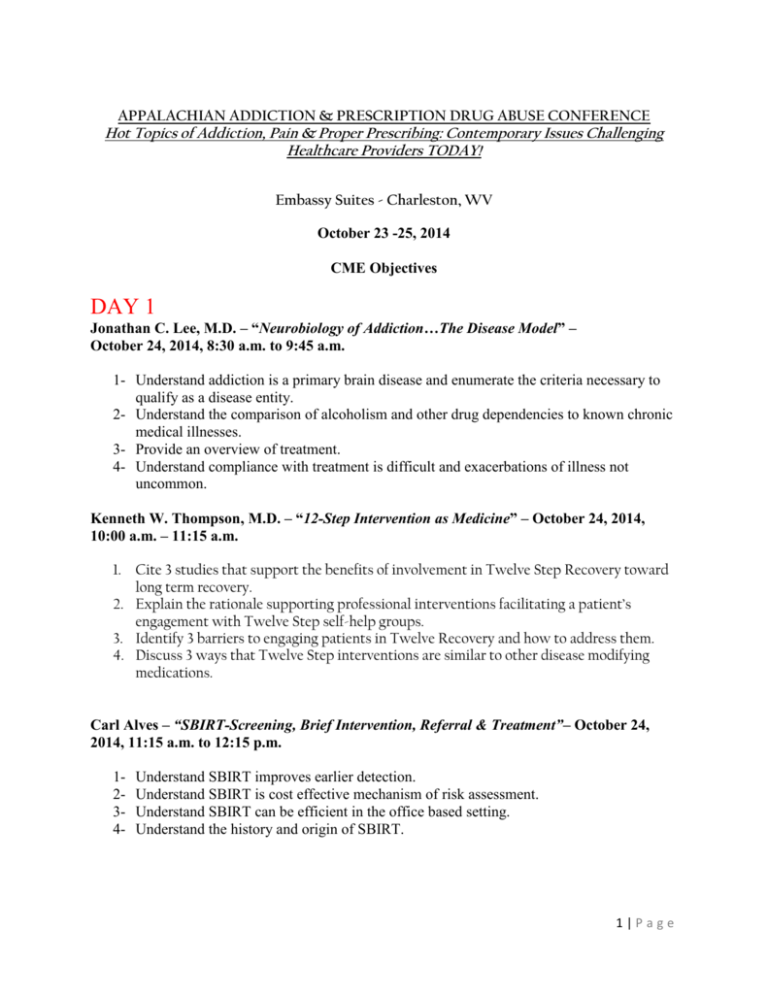
APPALACHIAN ADDICTION & PRESCRIPTION DRUG ABUSE CONFERENCE Hot Topics of Addiction, Pain & Proper Prescribing: Contemporary Issues Challenging Healthcare Providers TODAY! Embassy Suites - Charleston, WV October 23 -25, 2014 CME Objectives DAY 1 Jonathan C. Lee, M.D. – “Neurobiology of Addiction…The Disease Model” – October 24, 2014, 8:30 a.m. to 9:45 a.m. 1- Understand addiction is a primary brain disease and enumerate the criteria necessary to qualify as a disease entity. 2- Understand the comparison of alcoholism and other drug dependencies to known chronic medical illnesses. 3- Provide an overview of treatment. 4- Understand compliance with treatment is difficult and exacerbations of illness not uncommon. Kenneth W. Thompson, M.D. – “12-Step Intervention as Medicine” – October 24, 2014, 10:00 a.m. – 11:15 a.m. 1. Cite 3 studies that support the benefits of involvement in Twelve Step Recovery toward long term recovery. 2. Explain the rationale supporting professional interventions facilitating a patient’s engagement with Twelve Step self-help groups. 3. Identify 3 barriers to engaging patients in Twelve Recovery and how to address them. 4. Discuss 3 ways that Twelve Step interventions are similar to other disease modifying medications. Carl Alves – “SBIRT-Screening, Brief Intervention, Referral & Treatment”– October 24, 2014, 11:15 a.m. to 12:15 p.m. 1234- Understand SBIRT improves earlier detection. Understand SBIRT is cost effective mechanism of risk assessment. Understand SBIRT can be efficient in the office based setting. Understand the history and origin of SBIRT. 1|Page Chapman Sledge, M.D. – “Prescription Stimulants: Non-medical Use, Abuse & Addiction” – October 24, 2014, 1:00 p.m. to 1:45 p.m. 1- Identify how stimulants affect the brain and body. 2- Understand consequences of stimulant use and abuse. 3- Understand the steps in treating prescription stimulant addiction, detoxification and behavioral therapy. P. Bradley Hall, M.D. – “Dual Diagnosis, Co-morbidities & Addiction” – October 24, 2014, 2:15 p.m. to 3:15 p.m. 1234- Recognize common characteristics of addiction in patients. Understand addictive illness is common among patients with other medical illnesses. Recognize psychiatric illness occurs coincident with addictive illness. Understand outcomes of the treatment of addictive illness and psychiatric illness are improved when treated concurrently. 5- Understand addictive and psychiatric illness epidemiology with chronic pain and misuse of opioids. Doris Gundersen, M.D. – “Marijuana: “To be or not to be”, The Colorado Experience” – October 24, 2014, 3:15 p.m. to 4:45 p.m. 1234- Understand legislation that led to the legalization of marijuana for medicinal and then recreational use Recognize the acute and long-term health risks associated with the use of marijuana Become familiar with the research on potential benefits of marijuana use Recognize marijuana today is more potent than that of previous studies. Roland W. Gray, M.D. – “Physician Heal Thy Self – What is was like, what happened and what is it like now” – October 24, 2014, 6:30 p.m. to 8:00 p.m., Dinner Program 1- Recognize addictive illness is nondiscriminatory. 2- Understand healthcare professionals are human and therefore experience illnesses associated with the human condition. 3- Recognize the importance of 12-Step Programs. 4- Understand recovery from addictive illness is life-long. DAY 2 James Berry, D.O. – “Prescriber Beware: Prescription Drug Misuse, Diversion and Proper Prescribing” – October 25, 2014, 8 a.m. to 9:15 a.m. 1- Understand the epidemiology of chronic pain, the misuse of opioids and other prescription medications. 2|Page 2- Understand the identification of drug diversion present in our pain patients and communities which contribute to addictive illness. 3- Identify risk factors and signs of addiction which may contraindicate the prescribing of opioids and other potentially addictive medications. 4- Understand safeguards implemented with prescribing practices that minimize risk of diversion. 5- Understand and discuss West Virginia statistics on prescription drug diversion and abuse. Carl R. Sullivan, III, M.D. – “Medical Management of the Addicted Patient” – October 25, 2014, 9:15 a.m. - 10:15 a.m. 1- Recognize the availability of non-narcotic pharmacologic adjuncts in patient suspected of drug seeking behavior, diversion and/or addictive llness. 2- Understand office based opioid replacement therapy is useful in treating pain in patients with addictive illness. 3- Understand methadone utilized in the treatment of chronic pain is also utilized in the treatment of addictive illness in appropriate settings. 4- Understand basic detoxification of opioids and other addictive medications. Allen Mock, M.D. – Interim Chief Medical Examiner, Office of the WV Medical Examiner – “Prescription Drug Abuse Overdose Update: Current Statistics”- October 25, 2014, 10:45 a.m. to 11:30 a.m. 1- Understand and discuss current West Virginia statistics on prescription drug diversion and abuse. 2- Understand opioids and other common drugs of abuse related to overdose deaths. 3- Understand the role of heroin to overdose deaths relative to the proper opioid prescribing and increased utilization of the PDMP. Roland W. Gray, M.D. – “Neonatal Abstinence Syndrome/Mothers & Babies” – October 25, 2014, 12:15 p.m. to 1:00 p.m. 1234- Understand the two major types of neonatal abstinence syndrome, prenatal/postnatal Understand interdisciplinary intervention for the mother and her offspring Recognizing the substance exposed infant Understand the Tennessee experience related to neonatal abstinence syndrome and prescription opioids 5- Understand components of assessment and management of neonatal abstinence syndrome 3|Page James Ferguson, D.O. – “Urine Luck – Office Based Urine Drug Testing” - October 25, 2014, 1:15 p.m. to 2:15 p.m. 1- A greater understand of the types of drug testing available to clinicians. 2- A greater knowledge of drug testing types, specimens and analytes which are appropriate for various clinical populations. 3- A greater ability to interpret urine monitoring test results and use the interpretation to improve patient treatment and compliance. The Honorable Evan H. Jenkins, WV State Senator and Executive Director, WV State Medical Association – “West Virginia Laws, Rules & Regulations: A Prescriber’s Update”October 25, 2014, 2:15 p.m. to 2:45 p.m. a. Understand specific statutory requirements including rules and regulations of the West Virginia Board of Pharmacy, West Virginia Board of Medicine and West Virginia Board of Osteopathic Medicine relating to controlled substance prescribers. b. Understand recent legislative changes; compliance with controlled substance laws and rules related to substance abuse and prescription drug abuse. David Potters, J.D., Executive Director and General Counsel, WV Board of Pharmacy and Michael Goff, CSMP Administrator, WV Board of Pharmacy- “Use of the Controlled Substance Monitoring Program”- October 25, 2014, 2:45 p.m. to 3:30 p.m. 1- Understand and follow the steps necessary to register, log-on and use West Virginia's controlled substance monitoring program. 2- Understand recent updates to the controlled substance monitoring program. “Pearls & Best Practices in Prescription Drug Diversion, Drug Seeking & Prescribing” – October 25, 2014, 4:00 p.m. to 5:00 p.m. (Case Studies) 1- Case studies on best practices for indication of opioids in chronic pain treatment, general characteristics, including toxicities and drug interactions. 2- Case studies on risk assessment, examination and evaluation of the pain patient. 3- Case studies on the initiation and ongoing management of chronic pain patient treated with opioid based therapies, including treatment objectives; monitoring and periodic review; referrals and consultations; informed consent; prescription of controlled substance agreements, urine screens and pill counts; patient education on safe use, storage and disposal of opioids; discontinuation of opioids for pain due to lack of benefits or increased risks; documentation and medical records. 4- Utilization of urine drug testing in the monitoring of compliance /drug diversion in pain patients. 4|Page

